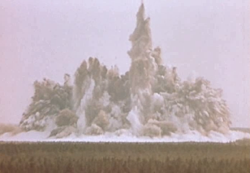 |
|
Taiga Experiment - 1971
 The Taiga experiment was part of the massive Pechora-Kama Channel project initiated by the Soviet Union in the Fall of 1969. The Pechora-Kama Channel project sought to divert water from the Arctic region into the Volga River basin and Caspian Sea. The steady decline in the water level of the Caspian Sea over the preceding 35 years as a result of climactic anomalies and municipal and agricultural uses of water from the Volga-Kama River system gave birth to the Pechora-Kama Channel project.
The Taiga experiment was part of the massive Pechora-Kama Channel project initiated by the Soviet Union in the Fall of 1969. The Pechora-Kama Channel project sought to divert water from the Arctic region into the Volga River basin and Caspian Sea. The steady decline in the water level of the Caspian Sea over the preceding 35 years as a result of climactic anomalies and municipal and agricultural uses of water from the Volga-Kama River system gave birth to the Pechora-Kama Channel project.
It was proposed to divert water from the Pechora River in the Komi Republic, which flows northward into the Barents and Kara Seas, through a 112 kilometers long channel into the Kama, which would then flow south to the Volga River and into the Caspian Sea. At one point, Soviet scientists proposed the use of several hundred nuclear explosions, detonated up to 20 at a time with yields as high as 3 megatons, to carve the channel out of the Earth. Preliminary cost estimates indicated that the use of nuclear devices, as apposed to traditional construction techniques, would reduce the cost of the project by a factor of 2 to 3.
The northern 30 kilometers of the area proposed for the channel was described as sandstone, siltstone, and argillite rock, media similar to the cratering media at the Semipalatinsk Test Site. However, the southern 35 kilometers of the area was largely saturated alluvial deposits that would present difficult slope stability problems. These concerns over the stability of the slopes of the nuclear channel caused the Ministry of Reclamations and Water Resources to sponsor a nuclear row-charge experiment in the southern area. This test was code-named Taiga.
The site of the PNE was about 100 kilometers north of the city of Krasnovishersk in the Perm Oblast. The alluvial deposits in this area varied in depth between 88 meters and 126 meters. Underlaying this alluvial section was sandstone and argillites and marl.
Three nuclear devices were used for this experiment, each had a 15 kiloton yield. They were placed in vertical shafts 124 meters deep at the base of the alluvial deposits. The devices were spaced 161 meters apart from each other. The nuclear devices were specially designed to have a minimal fission yield. Only 0.3 kilotons of the total yield came from fission reactions.
The three devices were fired simultaneously on February 23, 1971. The ground rose to a maximum height of 292 meters as a result of the explosion. The cloud reached an altitude of 1,755 meters. A crater 683 meters long and 331 wide was produced, almost 50% larger then predicted. The depth of the crater was only 10 ton 15 meters. The alluvial slopes failed, as predicted, and created the pan-shaped crater. The final crater slopes stabilized at an angle of about 8-10 degrees. The results of the Taiga tests indicated that nuclear explosives were probably not appropriate for the southern portion of the channel project.
Despite using low-fission devices, the radiation from the explosion was detected outside the Soviet Union by several countries, including the United States and Sweden. On site, the dose rate on the crater lip one hour after the explosion was 50-200 R/hr. Eight days after the explosion, at distances up to 5 miles downwind of ground zero, the dose rates were only twice that of natural background levels for the European part of Russia. A restricted area was established within 292 meters of the crater.
Interest remained in using nuclear devices in the Pechora-Kama Channel project despite the disappointing results of the Taiga experiment. In the late 1970s and 1980s, opposition to the project began to develop in academic and governmental circles. Primary concerns were about the environmental effects and possible climatological and hydrologic changes resulting from the transfer of significant volumes of water from the Arctic to the southern part of the country. The use of nuclear explosions for excavation was abandoned by the mid-1980s.
|
|
|
 |





